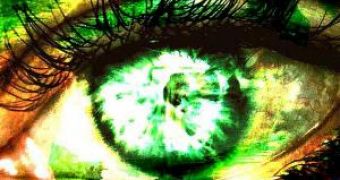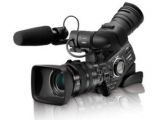Since we analyzed several visual-related hardware devices that connect to the PC, I figured out that we cannot ignore the streaming-video recording hardware components. Thus, the present article is going to present the camcorder and its most common variations that exist on the market.
The digital eye Camcorders are portable electronic devices which allow users to record video streams with audio onto an internal storage medium. The early camcorders, developed by JVC, Sony and Kodak, used analog videotape as the storage medium of choice, but since the mid-1990s, camcorders recording digital streams have become the industry standard.
The first camcorder patent was issued to the prolific American inventor Jerome Lemelson in 1980. Lemelson, who passed away in 1997, had tried to patent the idea for a camcorder as soon as 1977, but the U.S. Patent Office rejected his application, claiming that his invention was too far-fetched and that no company could ever be able to manufacture and sell the device. Among other things, Lemelson also invented crucial components for the video cassette recorder, Walkman, ATM and barcode-scanner. We will only concentrate on a brief time-line of the digital models for the sake of this article. The history of the camcorder is filled with many stepping stones and would alone make for an entire article. So, with the second half of 20th century's last decade, the camcorder reached the digital era and thus, the miniDV format was born. It still featured a cassette media which was even smaller than 8 mm conventional tape media, and this determined another size reduction of the tape transport assembly. The digital nature of the miniDV format once more improved the audio and video quality of the best of the existing analog consumer camcorders (such as SVHS-C and Hi8). Afterwards, digital-video camcorder evolved to include Digital8 and DVD or even HD technologies. The digital jump allowed camcorders to shrink more and more and, as of 2006, an entry-level digital camcorder may fit in the palm of a person's hand, with a price-tag of under $300 US.
Inside the camcorder Digital camcorders closely follow the analog design and contain 3 major components:
1. The lens system - its primary objective is to gather and focus light on the imager. This system is similar to the one found in digital cameras. It is the first component that interacts with the light rays. The camcorder's optical system may include adjustments for aperture (controlling the amount of light that passes through the lens), zoom (defining the field-of-view), and shutter speed (responsible for continuous motion capture). Consumer units feature automatic adjustments controlled by the camcorder's electronics, in order to maintain constant exposure onto the imager. As with the case of DSLR cameras, professional camcorders offer direct user control over all major optical functions (aperture, shutter-speed, focus, etc.)
2. The imager - in digital camcorders, we only find CCD or CMOS sensors as part of the imager. The imager section is basically acting like the eye of the camcorder, housing a photosensitive device. The main objective of the imager is to convert light into electronic video-signals through an elaborate electronic process. As I mentioned before, these processes are nearly the same as with the ones that involve photo camera image sensors. The camera lens projects an image onto the imager surface, exposing the photosensitive array to light. The light exposure is converted into electrical charge. At the end of the timed exposure, the imager converts the accumulated charge into a continuous analog voltage at the imager's output terminals. After scan-out is complete, the photosites are reset to start the exposure-process for the next video frame. In digital camcorders, the CCD or CMOS sensor has to be seconded by an analog-to-digital (ADC) converter in order to digitize the imager's analog waveform output into a discrete digital-video signal.
3. The recorder - encodes the video signal into a storable form. This last section is responsible for writing the video-signal onto a recording medium. The record function involves many signal-processing steps, and historically, the recording-process introduced some distortion and noise into the stored video, such that playback of the stored-signal may not retain the same characteristics/detail as the live video feed. The image recorded need not be limited to what appears in the viewfinder. Information concerning date, geographical position, names and other such things may also appear somewhere in the corner of the final video stream. Instead of storing the video signal as a continuous track of magnetic patterns, digital camcorders record the picture and sound as 1s and 0s on DVDs or hard disk drives. Digital camcorders are so popular because you can copy 1s and 0s very easily without losing any of the information you've recorded. Analog recordings are known to "fade" with each copy as the analog copying process doesn't reproduce the exact original signal. Moreover, digital video streams can also be loaded onto computers, where you can edit it with powerful software.
In addition, there is the viewfinder, which receives live video information, so you can see what you're shooting. Viewfinders in digital cameras are actually small, black-and-white or color LCD TVs. The trend today is to integrate larger full-color LCD screens.
Digital Pros at work A professional digital video camera is a high-end camcorder variant for recording electronic moving images (as opposed to high-end movie cameras, which can record the images on film). This type was originally developed for use in television studios. However, they are now commonly used for corporate and educational videos, music videos, direct-to-video movies, and so on.
The most outstanding piece of high-end equipment is the ENG video camera. Often used by independent film producers, this model is similar to consumer camcorders, and indeed, the dividing line between them is somewhat blurry, but several differences are noteworthy:
* They are bulkier, and usually have a shoulder stock for stabilizing on the cameraman's shoulder. * They use an array of 3 CCDs instead of the standard one in consumer digital cameras. ENGs sport one CCD for each primary (RGB) color. * They have removable/swappable lenses just like DSLR professional cameras * Concordantly, all advanced settings like white balance, focus, and iris can be manually adjusted, and auto ones can be completely disabled * If possible, these functions will be even mechanically adjustable (especially focus and iris). Passing signals to an actuator or digitally dampening the video signal does not provide a higher quality result. * They have professional connectors - BNC for video and XLR for audio. * A complete timecode setting is available, via which multiple cameras can be timecode-synchronized with a single cable. * Finally, they will use a professional medium like some digital variant of Betacam or DVCPRO, though DV formats can also be found.
Digital recoding media Digital camcorders usually record video streams and sound on flash memory devices, microdrives, small HDDs or size-reduced DVD-Rs in MPEG-1,MPEG-2 or MPEG-4 video formats.
These are the most common digital recording formats which can be found in today's digital camcorders:a) H.264 codec based AVCHD format, which records MPEG-4 AVC (H.264) compressed video to various kinds of media including recordable DVD discs, flash memories, hard disks, etc.
b) DV codec based formats include
- MiniDV and all the derived formats, including DVCPRO from Panasonic and DVCAM from Sony. DV recordings provide the highest quality pictures (comparable to broadcasting quality) on DV tapes that are easily transferable via Firewire or USB to PCs. Though designed as a consumer standard, there is extensive use of MiniDV in low-budget films and television productions, too - Digital8, that uses Hi8 tapes (Sony is the only company currently producing D8 camcorders). Some models even let users playback Hi8 analog format tapes. The format's technical specifications are of the same quality as MiniDV, but the professional paid no attention to this format as of yet.
c)MPEG-2 codec based formats include:
- MICROMV - this format makes use of a matchbox-sized cassette. This piece of hardware is no longer in production, though tapes are still available through Sony - the only company that used to produce this format. - DVD - records on small factor Mini DVD-R or DVD-RAM media. This is a multi-manufacturer standard that uses 8 cm DVD discs for only 30 minutes of video. However, these can be played directly on consumer DVD players, but cannot be further modified (as in rewrote or recorded to their fullest capacity if they haven't been already). For these necessities, there's the DVD-RAM format which can be added to and/or recorded over, but it has the downside of not being played on many consumer DVD players, costing more than the other formats, as well. The DVD-RW is another option allowing the user to re-record, but only records sequentially and must be explicitly finalized for viewing. DVD discs are also very vulnerable to scratches. DVD camcorders are generally not designed to connect to computers for editing purposes, though some high-end DVD units do record surround sound, a feature not standard with DV equipment. - HDV - records up to one hour of HDTV MPEG-2 signal roughly equal to broadcast quality HD on a standard MiniDV cassette.
We stop here for the time being. Tomorrow, we'll take a look at webcams and remote cameras.

 14 DAY TRIAL //
14 DAY TRIAL // 





